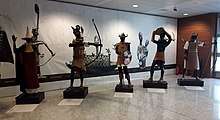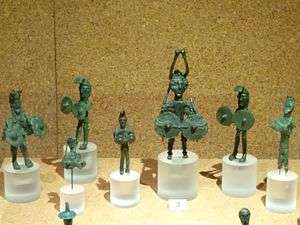Nuragic bronze statuettes


The Nuragic bronze statuettes (bronzetti in Italian, brunzittos or brunzittus in Sardinian) are typical Nuragic Sardinian bronze sculptures of the final phase of the Bronze Age and the early Iron Age.
During the archaeological excavations in Sardinia, more than 500 of these bronze statuettes have been discovered, mainly in places of worship like the holy wells and the so-called megara temples but also in villages and nuraghes. Several statues were also found in excavations carried out in central Italy and precisely in Etruscan tombs of the 9th-8th century BC.
Probably obtained with the lost wax technique, they can measure up to 39 cm. They represent scenes of everyday life of the nuragic people, depicting characters from various social classes, animal figures, warriors, chiefs, divinities, everyday objects and ships.
Archaeologists have not been able yet to date the figures accurately: they were allegedly made between the IX° century BC and the VI° century BC; however, the recent discoveries at Orroli and at Ballao [1][2] of fragments of bronze statues dating from the XIII° century BC have called into question their effective date. Arcaehologist Ralph A. Gonzalez dated the earliest types of bronze statuettes to the 12-11th century bc [3]
Gallery
- Some Sardinian bronze statuettes dating from the Nuragic period
 Nuragic warrior from Sulcis (Pigorini National Museum of Prehistory and Ethnography, Rome)
Nuragic warrior from Sulcis (Pigorini National Museum of Prehistory and Ethnography, Rome) Some Nuragic statuettes on display at the National Archaeological Museum of Cagliari (Sardinia)
Some Nuragic statuettes on display at the National Archaeological Museum of Cagliari (Sardinia)- Nuragic bronze statuette nicknamed "the mother of the killed" found in Urzulei

- Nuragic bronze statuette showing an archer with a kilt from Sardara
- A Sardinian archer from Sardara
- A Sardinian archer from the Nuragic Sanctuary of Abini in Teti
- Sardinian four-eyed and four-legged hero from the Nuragic Sanctuary of Abini
- Sardinian chieftain from Serri
- Ship model from Ardara
| Wikimedia Commons has media related to Nuragic bronze statuettes in Sardinia. |
Notes
Bibliography
- AA.VV., La civiltà in Sardegna nei secoli, Torino, Edizioni ERI.
- Casula F.C., La storia di Sardegna, Sassari, 1994.
- Foddai L., Sculture zoomorfe. Studi sulla bronzistica figurata nuragica, Cargeghe, 2008.
- Lilliu, G. La civiltà dei Sardi dal neolitico all'età dei nuraghi, Torino, Edizioni ERI, 1967.
- Lilliu G. Sculture della Sardegna nuragica, Verona, 1962.